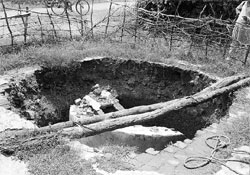Poisoned Water
 They pay the real price of mining with their parched throats and poisoned bodies. For some 400 villages in and around the Talcher coalfields of Orissa, it is a mad rush for water. Wells are sinking, the water table is constantly falling and even deep tubewells yield nothing. "In the last one decade around 100 wells and numerous borewells have been rendered useless', says Sisir Tripathy, coordinator of the District Action Group (DAG), a federation of 21 non-governmental organisations of Dhenkanal district, who are protesting against the ills of rampant coal mining and subsequent industrialisation of the district.
They pay the real price of mining with their parched throats and poisoned bodies. For some 400 villages in and around the Talcher coalfields of Orissa, it is a mad rush for water. Wells are sinking, the water table is constantly falling and even deep tubewells yield nothing. "In the last one decade around 100 wells and numerous borewells have been rendered useless', says Sisir Tripathy, coordinator of the District Action Group (DAG), a federation of 21 non-governmental organisations of Dhenkanal district, who are protesting against the ills of rampant coal mining and subsequent industrialisation of the district.
Groundwater availability in Talcher has been poor. But the Brahmani river provided plenty of water to sustain a predominantly agrarian economy. With mining activities picking up after India's independence, several water intensive industries came up. The Talcher-Angul region is how considered a
Related Content
- Judgment of the National Green Tribunal regarding sewage discharge into storm water drains which meet river Yamuna, 21/11/2024
- Order of the National Green Tribunal regarding pollution being caused in the Kotwan Industrial area, Mathura district, Uttar Pradesh, 04/10/2023
- Order of the National Green Tribunal regarding water pollution in Ladakh, 06/04/2023
- Joint committee report on the dumping of sewage in the green belt area, Ansal estate, Loni, Ghaziabad, Uttar Pradesh, 21/11/2022
- Innocenti Report Card 17- Places and Spaces: Environments and children's well-being
- Order of the National Green Tribunal regarding pollution of Shillong rivers, Meghalaya, 28/04/2022
